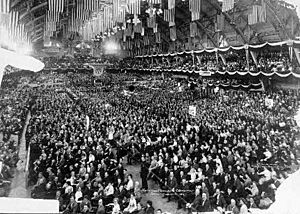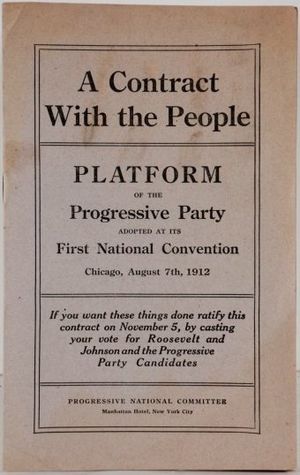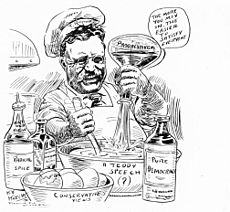Bull Moose Party facts for kids
Quick facts for kids
Progressive Party
|
|
|---|---|
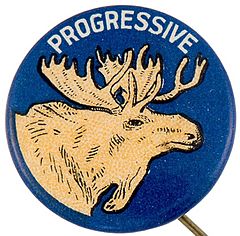
The bull moose was the party's official mascot
|
|
| Chair | Theodore Roosevelt |
| Founded | 1912 |
| Dissolved | 1920 |
| Split from | Republican Party |
| Preceded by | Lincoln–Roosevelt League |
| Merged into | Republican Party (majority) |
| Succeeded by | California Progressive Party |
| Headquarters | Washington, D.C., U.S. |
| Ideology | Progressivism Radicalism New Nationalism |
| Colors | Red |
The Progressive Party, often called the Bull Moose Party, was a new political party in the United States. It was started in 1912 by former president Theodore Roosevelt. He formed it after he lost the chance to be the Republican Party's candidate for president. His opponent was the current president, William Howard Taft, who used to be his friend.
The Progressive Party was known for wanting many new and modern changes. These changes were called "progressive reforms." The party also attracted many important reformers from across the country. The "Bull Moose" nickname came from Roosevelt himself. He said he felt "strong as a bull moose" after losing the Republican nomination.
After the 1912 election, the party quickly became less popular. It mostly disappeared by 1920.
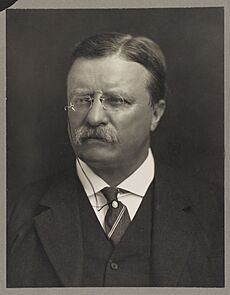
Contents
- Why the Progressive Party Started
- What the Progressive Party Believed In
- The 1912 Election and Its Impact
- Losing to President Taft
- Forming the New Party
- The Progressive Convention and Its Goals
- The 1912 Election Campaign
- The Party's Decline
- Progressive Party Election Results
- People Who Held Office as Progressives
- See also
Why the Progressive Party Started
Theodore Roosevelt was a Republican president from 1901 to 1909. Towards the end of his time in office, he became more interested in progressive ideas. In 1908, Roosevelt helped his friend, Secretary of War William Howard Taft, become the next president.
Taft wanted to continue Roosevelt's plans for the country, called the "Square Deal." However, Taft made some decisions that upset Roosevelt. These disagreements caused a split in the Republican Party. Many progressive Republicans then supported Roosevelt when he decided to run for president again in 1912. At that time, there was no rule against a president serving more than two terms.
At the Republican Party's meeting in 1912, Taft barely won the nomination over Roosevelt. After this, Roosevelt and his supporters left the Republican Party. They decided to create their own party, the Progressive Party. They chose Roosevelt as their presidential candidate and Hiram Johnson of California as his running mate.
What the Progressive Party Believed In
The party's main ideas were based on Roosevelt's "Square Deal" plan. They wanted many progressive changes for the country. The party believed that "corrupt business and corrupt politics" were working together. They said their first goal was to break up this "unholy alliance."
Here are some of the changes the Progressive Party wanted:
- Rules for how political campaigns could get money.
- Lower taxes on imported goods (called tariffs).
- A system to help people who were old, unemployed, or disabled.
- An eight-hour workday.
- The right for women to vote (women's suffrage).
Some members of the party disagreed on how to control large companies. Others, like Jane Addams, did not agree with Roosevelt's idea to build up the navy.
The 1912 Election and Its Impact
In the 1912 election, Roosevelt got 27.4% of the votes. Taft got 23.2%. This meant Roosevelt was the only third-party candidate in U.S. history to get more votes than a major party candidate. However, both Roosevelt and Taft lost to the Democratic candidate, Woodrow Wilson. Wilson won with 41.8% of the votes and most of the electoral votes.
The Progressive Party did elect some members to Congress and state governments. But the election mostly helped the Democratic Party gain power.
Losing to President Taft
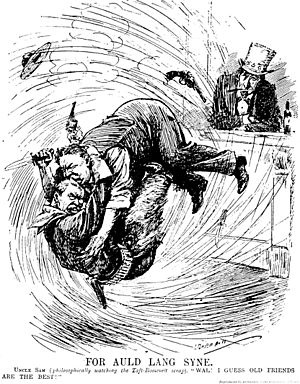
Roosevelt had chosen Taft to follow him as president. He thought Taft would agree with his ideas. Taft easily won the 1908 election. But Roosevelt became unhappy with Taft's more conservative policies. Roosevelt felt very upset when Taft used a law against big businesses (the Sherman Anti-Trust Act) to sue a company that Roosevelt had approved.
They became open enemies, and Roosevelt decided to run for president again in early 1912. Taft was already facing a challenge from Senator Robert La Follette. But many of La Follette's supporters switched to Roosevelt.
Some states held special elections to choose their party's candidate. Roosevelt won these elections. However, Taft had worked hard to control the Republican Party's organization. He also gained support from delegates in Southern states. At the Republican meeting in 1912, Taft narrowly won the nomination. Roosevelt and his supporters then left the meeting.
Forming the New Party
The day after the Republican meeting, Roosevelt's supporters met to start their own political party. California Governor Hiram Johnson became its leader. A new meeting was planned for August. Rich supporters provided most of the money for the new party.
Important leaders in the new party included Jane Addams, a social worker and advocate for women's rights. Others were former Senator Albert J. Beveridge, who wanted to regulate industries, and Gifford Pinchot, a famous environmentalist. Many publishers who exposed corruption also joined. The main organizers were Senator Joseph M. Dixon and George Walbridge Perkins, a banker. Perkins helped organize the new party.
The new party faced challenges. Most Republican politicians did not want to leave their party to support Roosevelt. Only a few progressive Republican senators joined the new party. Very few Democrats joined either. This meant most of Roosevelt's old political friends stayed with the Republican Party.
The Progressive Convention and Its Goals
The Progressive Party's meeting in August was very exciting. More than 2,000 people attended, including many women. Neither Taft nor Wilson supported women's right to vote at the national level in 1912. Jane Addams spoke in support of Roosevelt's nomination. Roosevelt was chosen as the candidate, with Johnson as his running mate.
The most important part of the meeting was creating the party's platform. This platform explained what the new party promised voters. It included many social and political changes that progressives had wanted for a long time. Roosevelt promised that their cause was based on what was right and would eventually win.
The platform's main idea was to stop big businesses from controlling politics. It said that both the Republican and Democratic parties were controlled by business interests. The platform stated:
To destroy this invisible Government, to dissolve the unholy alliance between corrupt business and corrupt politics is the first task of the statesmanship of the day.
To achieve this, the platform called for:
- Strict rules on money given to political campaigns.
- Making lobbyists (people who try to influence politicians) register.
- Recording and publishing what happens in Congress meetings.
In terms of social issues, the platform wanted:
- A national health service.
- Social insurance for the elderly, unemployed, and disabled.
- Limits on judges stopping labor strikes.
- A minimum wage for women.
- An eight-hour workday.
- Help for farmers.
- Payments for workers injured on the job.
- A tax on inherited money.
The political changes proposed included:
- Women's right to vote.
- Direct election of senators by the people.
- Primary elections for choosing candidates.
- Easier ways to change the United States Constitution.
The platform also encouraged states to allow citizens to:
- Remove elected officials before their term ends (recall election).
- Vote on laws directly (referendum).
- Propose and pass laws by collecting signatures (initiative).
- Overturn court rulings by popular vote (judicial recall).
The platform also wanted lower tariffs and limits on naval weapons through international agreements. Roosevelt was likely the first major politician to call for health care reform.
A big debate at the meeting was about how to deal with large companies and monopolies. The party wanted to break up these "trusts." But the final platform used weaker language, talking about "strong National regulation" instead. This upset some reformers and caused a split in the party.
Overall, the platform showed Roosevelt's "New Nationalism" idea. This meant a strong government that would regulate industries, protect workers, and lead big national projects. Roosevelt also wanted a strong foreign policy and military.
The 1912 Election Campaign

Roosevelt campaigned very hard, but his campaign did not have much money. Many businesses that had supported him before now supported other candidates or stayed neutral. Roosevelt also faced a challenge because he had already been president for almost two full terms.
In the end, Roosevelt did not win. He received 4.1 million votes, which was 27% of the total. This was less than Wilson's 42% but more than Taft's 23%. Roosevelt got 88 electoral votes, while Wilson got 435 and Taft got 8. This was the best result for any third party since 1864. Roosevelt was the only third-party candidate to get more votes than a major party candidate.
The split in the Republican Party helped Wilson win the presidency. Many other candidates also ran as Progressives in 1912.
On October 14, 1912, while campaigning in Milwaukee, Wisconsin, Roosevelt was shot. The bullet hit his chest but was slowed by his eyeglass case and a folded speech in his pocket. Roosevelt, an experienced hunter, knew the bullet had not reached his lung. He refused to go to the hospital right away. Instead, he gave his speech for 90 minutes, even with blood on his shirt. He famously told the crowd, "Ladies and gentlemen, I don't know whether you fully understand that I have just been shot, but it takes more than that to kill a Bull Moose." Doctors later decided it was safer to leave the bullet in his chest. Roosevelt carried it for the rest of his life.
Both Taft and Wilson stopped their campaigns until Roosevelt recovered. When asked about the shooting, Roosevelt said, "I'm fit as a bull moose," which further inspired the party's symbol. He recovered for two weeks before returning to campaigning.
The Party's Decline
1914 and 1916 Elections
Even though they did well in 1912, the Progressive Party started to fade. The Republican Party began to regain its strength. In 1914, 138 candidates ran for the U.S. House as Progressives, but only 5 were elected. Many candidates got very few votes.
In 1916, the Progressive Party held its national meeting at the same time as the Republican meeting. They hoped to reunite the parties with Roosevelt as the candidate for both. However, the Republicans did not want Roosevelt. Instead, they chose Charles Evans Hughes, a moderate progressive. Roosevelt refused the Progressive nomination and told his supporters to vote for Hughes.
After this, the Progressive Party largely fell apart. Most Progressives, including Roosevelt, rejoined the Republican Party. Some, like Harold L. Ickes, supported Wilson and later worked in President Franklin D. Roosevelt's government.
Later Years
In 1924, Robert M. La Follette Sr. started another Progressive Party for his presidential campaign. A third Progressive Party was formed in 1948 for former vice president Henry A. Wallace's campaign.
From 1916 to 1932, the Republican Party was controlled by more conservative members. They did not nominate any of the prominent 1912 Progressives for national office. Eventually, many former Progressives joined the Democratic Party in the 1930s, supporting President Franklin D. Roosevelt's "New Deal" programs.
Progressive Party Election Results
In Congress
|
|
In Presidential Elections
| Election | Candidate | Running mate | Votes | Vote % | Electoral votes | +/- | Outcome of election |
|---|---|---|---|---|---|---|---|
| 1912 |  Theodore Roosevelt |
 Hiram Johnson |
4,122,721 | 27.4 |
88 / 531
|
Democratic victory | |
| 1916 |  Theodore Roosevelt (refused nomination) |
 John M. Parker |
33,406 | 0.2 |
0 / 531
|
Democratic victory |
People Who Held Office as Progressives
| Position | Name | State | Dates held office |
|---|---|---|---|
| Representative | James W. Bryan | Washington | 1913–1915 |
| Governor | Joseph M. Carey | Wyoming | 1911–1912 as a Democrat, 1912–1915 as a Progressive |
| Representative | Walter M. Chandler | New York | 1913–1919 |
| Representative | Ira Clifton Copley | Illinois | 1915–1917 as a Progressive |
| State Representative | Bert F. Crapser | Michigan | 1913–1914 |
| Representative | John Elston | California | 1915–1917 as a Progressive, 1917–1921 as a Republican |
| Lieutenant Governor | John Morton Eshleman | California | 1915–1917 |
| Representative | Jacob Falconer | Washington | 1913–1915 |
| Representative | William H. Hinebaugh | Illinois | 1913–1915 |
| Representative | Willis J. Hulings | Pennsylvania | 1913–1915 |
| Governor | Hiram Johnson | California | 1911–1915 as a Republican, 1915–1917 as a Progressive |
| Representative | Melville Clyde Kelly | Pennsylvania | 1917–1919 as a Progressive, 1919–1935 as a Republican |
| Representative | William MacDonald | Michigan | 1913–1915 |
| Representative | Whitmell Martin | Louisiana | 1915–1919 as a Progressive, 1919–1929 as a Democrat |
| Senator | Miles Poindexter | Washington | 1913–1915 |
| Representative | William Stephens | California | 1913–1917 |
| Representative | Henry Wilson Temple | Pennsylvania | 1913–1915 |
| Representative | Roy Woodruff | Michigan | 1913–1915 |
| State Treasurer | Homer D. Call | New York | 1914 |
| Mayor | Louis Will | Syracuse, New York | 1914–1916 |
See also
 In Spanish: Partido Progresista (Estados Unidos, 1912) para niños
In Spanish: Partido Progresista (Estados Unidos, 1912) para niños
- California Progressive Party
- Committee of 48
- Lincoln–Roosevelt League, the California Progressive Party in the early 1900s
- Minnesota Progressive Party
- Oregon Progressive Party
- Populist Party (United States)
- Progressive Party (United States, 1924)
- Progressive Party (United States, 1948)
- Vermont Progressive Party
- Wisconsin Progressive Party


